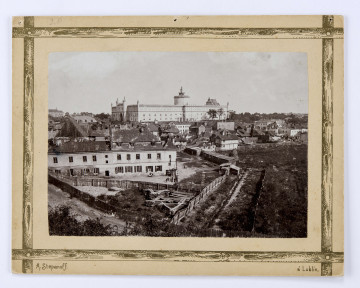
Photograph of the Maharshal Synagogue and the prison at the Lublin Castle
National Museum in Lublin
Part of the collection: Lubliniana. Painting views of Lublin and the Lublin Region
Symcha Binem Trachter (1894-1942) was born into a wealthy middle-class family. His father ran a textile store on Lubartowska Street, the longest street in Lublin's Jewish quarter. In 1911, Trachter began his studies at the School of Fine Arts in Warsaw, which he continued at the Academy of Fine Arts in Krakow under the supervision of Jacek Malczewski, Stanisław Dębicki, Teodor Axentowicz, and Stanisław Kamocki. In 1925 he left for Paris, where at the private Académie Ranson he perfected his painting craft, studied the canvases presented at the Louvre, and learned Cézanne’s method of constructing compositions. Earlier, after completing his studies in Krakow, the artist returned briefly to Lublin, where in 1921 he made a series of drawings devoted to the architecture of his hometown. Sketched in black crayon, the views reveal a solid, academic mastery of drawing, as well as an individual, sensitive feeling for architecture, which Trachter combined with a realistic perception, devoid of idealization. Among the few surviving sketches made by the artist at that time is a carefully composed view of the interior of the Maharshal Synagogue. The Maharshal Synagogue, also known as the Great Synagogue, was the spiritual centre of the Jewish quarter in Lublin. It was the largest and the most magnificent building erected by Jews in Lublin. It was built in 1567 at the foot of the northern slope of Zamkowy Hill, in Jateczna Street, which does not exist today. The synagogue was named after the Lublin rabbi, yeshiva rector Salomon Luria, called Maharszal, who was given the title of rector by King Sigismund II Augustus. Trachter focused on presenting the main prayer room illuminated by magnificent, decorative chandeliers. The centre of the carefully thought-out composition is the bimah, from which the Torah was read and prayers were conducted. Surrounded by a balustrade, the quadrilateral elevation of the Lublin synagogue was distinguished by a magnificent architectural setting, just like the aron ha-kodesh, an altar cabinet presented in the background, used for storing the scrolls of the Pentateuch. The documentary approach evident in Trachter's drawings is reflected in his attention to the faithful reproduction of architectural details, which the artist precisely brings out with his soft line.
Anna Hałata
Author / creator
Dimensions
cały obiekt: height: 29,4 cm, width: 37 cm
Object type
drawing
Material
paper
Creation time / dating
Creation / finding place
Owner
The National Museum in Lublin
Identification number
Location / status

National Museum in Lublin

1880 — 1900
National Museum in Lublin

National Museum in Lublin
DISCOVER this TOPIC
Museum of King Jan III's Palace at Wilanów
DISCOVER this PATH
Educational path